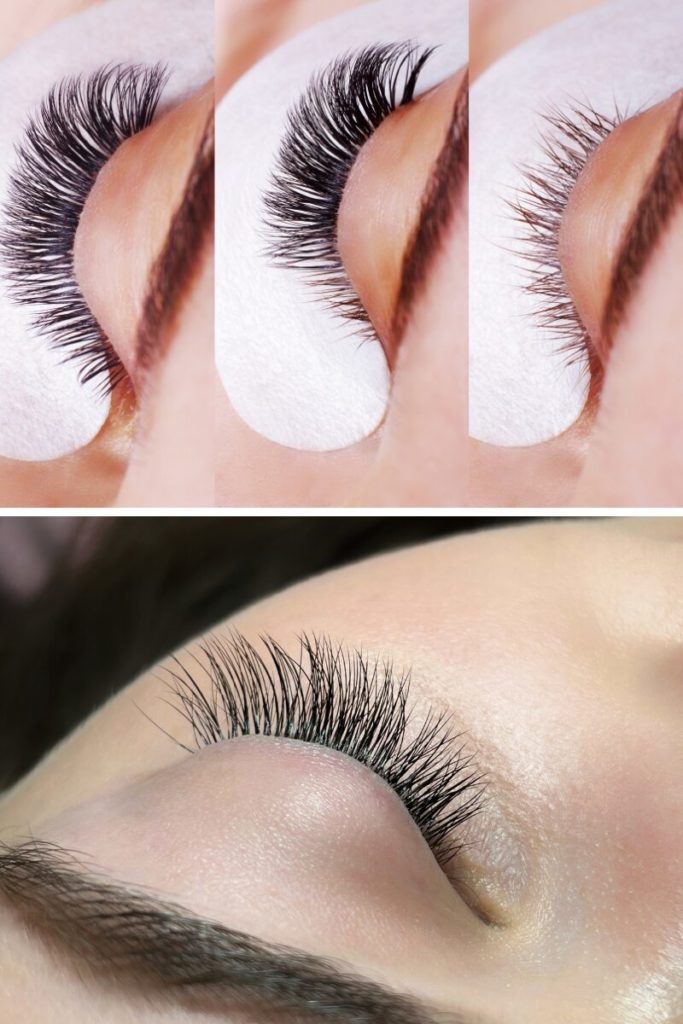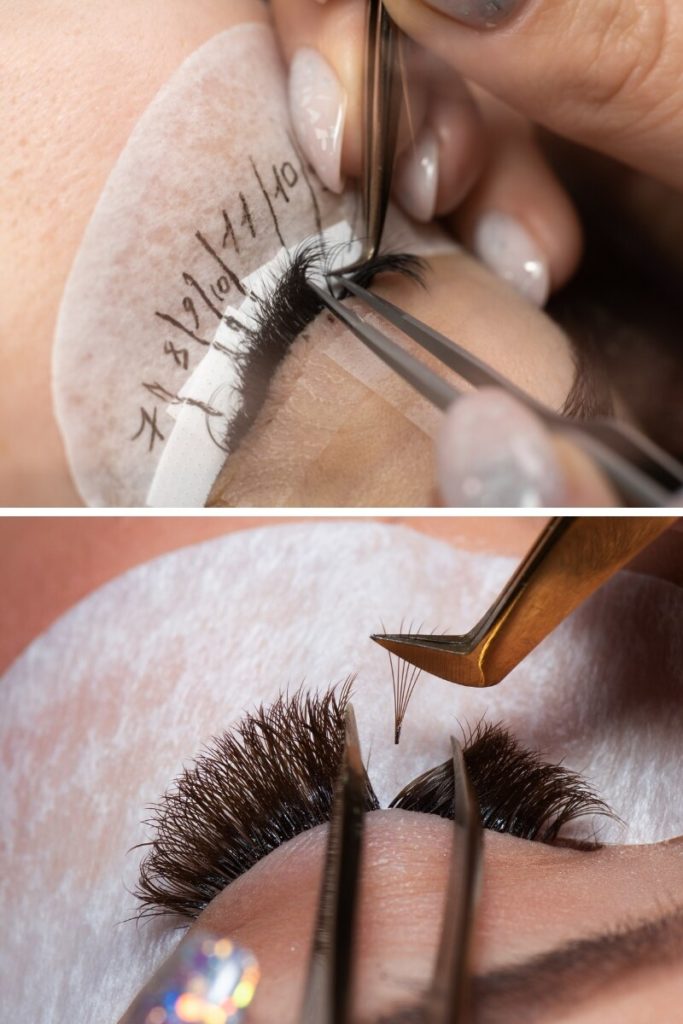Eyelash extensions can enhance your natural beauty by making your lashes look longer, fuller, and more defined. However, some people may experience an eyelash extension allergic reaction. This can be concerning, but understanding the causes, prevention, and treatment can help you manage this situation effectively.
What Causes Allergic Reactions to Eyelash Extensions?
Eyelash extension allergic reactions are often caused by the adhesives used during the application process. These adhesives contain various chemicals that can trigger allergies in some individuals.
- Common Allergens in Lash Adhesives:
- Cyanoacrylate: This is the main ingredient in most eyelash glues and is known for causing allergies.
- Formaldehyde: Although not always present in high-quality adhesives, trace amounts can cause reactions.
- Carbon Black: Used to color the glue black, it can be a culprit for those with sensitive skin.
- Latex: Some glues contain latex, which can cause reactions in individuals allergic to latex.
Recognizing the symptoms of an allergic reaction early can help manage the situation better.
- Symptoms of an Allergic Reaction:
- Swollen eyelids
- Red, itchy eyes
- Watery eyes
- Burning sensation around the eye area
- Pain or discomfort in the eyes

If you experience these symptoms, it’s important to seek help promptly.
Prevention Tips for Eyelash Extension Allergic Reactions
Preventing an eyelash extension allergic reaction involves a few proactive steps. These measures can help ensure that your lash extension experience is safe and comfortable.
Conducting Patch Tests
Conducting a patch test before applying a full set of extensions can help identify potential allergies.
- Why Patch Tests are Important:
- Identify allergic reactions before the full application.
- Protects clients from severe reactions.
- Builds trust and professionalism in your services.
A patch test involves applying a small amount of adhesive to the client’s skin and waiting to see if there is any reaction.
Choosing the Right Adhesives
Using hypoallergenic or sensitive adhesives can significantly reduce the risk of allergic reactions.
- Types of Sensitive Adhesives:
- Hypoallergenic Adhesives: Formulated to minimize allergic reactions.
- Clear Adhesives: Do not contain carbon black, which can be an allergen.
- Latex-Free Adhesives: Essential for clients with latex allergies.
Also Trending: Do Lash Lifts Damage Your Lashes? Discover The Truth
Selecting the right adhesive for your clients can make a big difference in their comfort and safety.
Proper Ventilation and Workspace Hygiene
A well-ventilated workspace and maintaining hygiene are crucial in preventing allergic reactions.
- Ventilation and Hygiene Practices:
- Use fans to disperse adhesive fumes.
- Keep the workspace clean and free of dust.
- Regularly sanitize all tools and equipment.
Good ventilation and cleanliness can help reduce exposure to allergens.

By implementing these prevention tips, you can ensure a safer experience for your clients and reduce the chances of an eyelash extension allergic reaction.
How to Handle an Allergic Reaction
Even with preventive measures, allergic reactions can still occur. Knowing how to handle them is crucial.
Immediate Steps to Take
If a client experiences an allergic reaction, it’s important to act quickly.
- First Steps:
- Remove the Extensions: Gently remove the extensions using a professional remover.
- Clean the Eye Area: Use a gentle, non-irritating cleanser to clean the affected area.
- Seek Medical Help: Advise the client to consult a doctor, especially if the reaction is severe.
Quick action can help alleviate the symptoms and prevent further complications.
Home Remedies and Treatments
For mild reactions, there are several home remedies and treatments that can help soothe the symptoms.
- Effective Home Remedies:
- Cold Compress: Apply a cold compress to reduce swelling and irritation.
- Antihistamines: Over-the-counter antihistamines can help reduce allergic symptoms.
- Anti-Inflammatory Creams: Applying a minimal amount of cortisone cream can help reduce inflammation.
- Conclusion of Home Remedies: These remedies can provide relief, but it’s important to monitor the symptoms and seek medical advice if they persist or worsen.

Handling an allergic reaction properly can help your clients feel more comfortable and confident in your services.
Alternatives to Eyelash Extensions
For clients who experience allergic reactions to eyelash extensions, there are several alternatives that can provide similar results without the risk.
- Strip Lashes: These can be applied using latex-free adhesive and removed daily.
- Magnetic Lashes: Use tiny magnets instead of glue, reducing the risk of allergic reactions.
- Lash Serums: Promote natural lash growth, providing length and volume without extensions.
Each of these alternatives has its own benefits and can be a good option for those who are sensitive to lash adhesives.
How Lash Beauty Bar Ensures Safe and Comfortable Eyelash Extensions
At Lash Beauty Bar, we prioritize your safety and comfort. Our approach to preventing and managing eyelash extension allergic reactions is comprehensive and client-focused.
Our Approach to Client Safety
We take several measures to ensure that our clients have a safe and pleasant experience.
- Patch Testing: We conduct patch tests for new clients and when using new products.
- Hypoallergenic Products: We use high-quality, hypoallergenic adhesives to minimize the risk of reactions.
- Personalized Consultations: We provide personalized consultations to understand each client’s needs and sensitivities.
Professional Training and Hygiene Standards
Our team is highly trained and follows strict hygiene protocols to ensure your safety.
- Training Programs: Our stylists undergo rigorous training to stay updated on the latest techniques and safety practices.
- Sanitation Practices: We maintain a clean and sanitized workspace, using sterile tools for each client.
- Ventilation Systems: Our studio is equipped with advanced ventilation systems to reduce exposure to adhesive fumes.
By adhering to these standards, we aim to provide a safe and enjoyable experience for all our clients.
Q&A on Eyelash Extension Allergic Reactions
Can I get lash extensions again if I had an allergic reaction before?
Yes, you can, but it requires caution. Consult with your lash technician and consider using hypoallergenic adhesives. Always do a patch test before a full application.
How do I differentiate between irritation and an allergy?
Irritation typically causes minor redness and discomfort that subsides within a day or two. Allergies cause more severe symptoms like swelling, persistent redness, and itching that do not go away quickly.
What should I do if I experience a reaction at home?
Remove the extensions using a professional remover if possible, apply a cold compress, and take an antihistamine. Consult with a doctor if the symptoms are severe or persistent.
Also Trending: Is Brow Lamination Worth It? Everything You Need to Know
Conclusion
Understanding and managing an eyelash extension allergic reaction is crucial for both clients and lash technicians. By taking preventive measures, knowing how to handle reactions, and considering alternatives, you can enjoy the beauty of eyelash extensions safely. At Lash Beauty Bar, we are committed to providing a safe and comfortable experience for all our clients. If you have any concerns or need further information, please don’t hesitate to contact us.
- Phone: (470) 592 – 3355
- Address: 1875 Old Alabama Rd STE 840, Roswell, GA 30076
- Email: lashbeautybar.atl@gmail.com
We look forward to helping you achieve the beautiful lashes you’ve always wanted, safely and comfortably!

